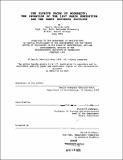The elusive faces of modernity : the invention of the 1937 Paris Exhibition and the Temps Nouveaux pavilion
Author(s)
Udovicki-Selb, Danilo
DownloadFull printable version (57.28Mb)
Alternative title
Invention of the 1937 Paris Exhibition and the Temps Nouveaux pavilion
Advisor
Stanford Anderson.
Terms of use
Metadata
Show full item recordAbstract
The 1937 Paris Exhibition, the "final European enactment of the ritual of peace and progress before the deluge," remains the least researched and most misunderstood in the history of the World's Exhibitions in France. This study deals primarily with the years that preceded the opening of the Exhibition and with the broad debates that led to its "invention." In order to establish the historical foundations of the Exhibition, attention is given first to the political, aesthetic and economic discourses developed throughout the nineteenth century in France on the occasion of its Expositions Universelles. This analysis reveals the existence of a specific typology of the French Exposition Universelle grounded in the French Enlightenment and in its encyclopedist ideals. The present study claims that this type culminates in the 1867 Exhibition, when, for the first time, the Dideroan encyclopedist ideal and the Saint-Simonian modernist credo--two theoretical premises of these exhibitions-- receive their most convincing spatial translation. Conversely, the 1937 Exhibition appears as the "end" of this long typological development when the specific spatial concept of the Exposition Universelle created in the eighteenth century finally collapses. This evolution reflects two different approaches to the Enlightenment. One stems from an authoritarian interpretation of the encyclopedist universalism which appeals to Napoleon Ill's regime. The other emerges as a populist, and perhaps Voltairian interpretation of the Siecle des Lumieres that reaches its full expression in 1937, hand in hand with the advent of the Front Populaire. The evanescence of the nineteenth century universalist authoritarianism, and its concomitant quest for a controlling style creates an ambiguous space for the emergence of a planned stylistic pluralism. Such relativization of the concept of style, evident in 1937, in turn announces the end of the concept of "style" altogether, or else of modernity understood as an issue of style. The principled openness to "all styles" propounded by the leadership of the 1937 Exhibition alienates from the outset, the most radical proponents of modernism in the arts, on suspicions of cultural fraud. Such accusations set the stage for still enduring misinterpretations of the event, namely for the belief that the leadership of the 1937 Exhibition was part of a conspiracy against "progressive" modernity. Under such circumstances, current scholarship explains the apparently paradoxical presence of many modernist architects and artists at the 1937 Exhibition as the work of the Front Populaire. The present study explains why this was not the case. The central place given here to Le Corbusier reflects the major role the architect played in his militant efforts to take control over the ...
Description
Thesis (Ph. D.)--Massachusetts Institute of Technology, Dept. of Architecture and Planning, 1994. Includes bibliographical references (p. 342-374).
Date issued
1994Department
Massachusetts Institute of Technology. Department of Architecture; Massachusetts Institute of Technology. Department of Urban Studies and PlanningPublisher
Massachusetts Institute of Technology
Keywords
Architecture, Urban Studies and Planning